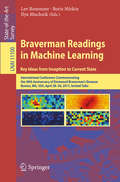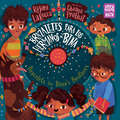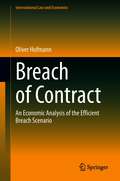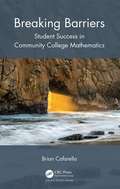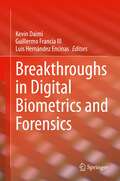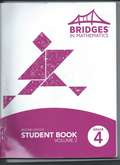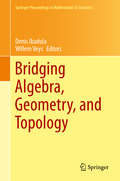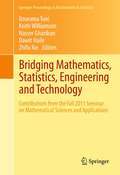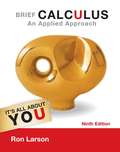- Table View
- List View
Braverman Readings in Machine Learning. Key Ideas from Inception to Current State: International Conference Commemorating the 40th Anniversary of Emmanuil Braverman's Decease, Boston, MA, USA, April 28-30, 2017, Invited Talks (Lecture Notes in Computer Science #11100)
by Boris Mirkin Lev Rozonoer Ilya MuchnikThis state-of-the-art survey is dedicated to the memory of Emmanuil Markovich Braverman (1931-1977), a pioneer in developing machine learning theory.The 12 revised full papers and 4 short papers included in this volume were presented at the conference "Braverman Readings in Machine Learning: Key Ideas from Inception to Current State" held in Boston, MA, USA, in April 2017, commemorating the 40th anniversary of Emmanuil Braverman's decease. The papers present an overview of some of Braverman's ideas and approaches.The collection is divided in three parts. The first part bridges the past and the present and covers the concept of kernel function and its application to signal and image analysis as well as clustering. The second part presents a set of extensions of Braverman's work to issues of current interest both in theory and applications of machine learning. The third part includes short essays by a friend, a student, and a colleague.
Brazaletes para los hermanos de Bina / Bracelets for Bina's Brothers (Storytelling Math)
by Rajani LaRocca¡Celebremos la diversidad, las matemáticas y el poder del cuento! Celebrate diversity, math, and the power of storytelling with this bilingual (Spanish and English) edition!¡Ahora en edición bilingüe inglés-español! Para la celebración hindú Raksha Bandhan, Bina decide regalarles a sus hermanos brazaletes de cuentas hechos por ella misma. Para eso averigua qué colores le gusta a cada uno y cuáles no, y se pone manos a la obra. Al seguir patrones de cuentas de colores alternados, uno y uno, Bina descubre algo nuevo sobre los patrones... y sobre sus hermanos. Los libros de la serie Cuentos matemáticos celebran las aventuras diarias de niños que usan las matemáticas mientras juegan, construyen y descubren el mundo que los rodea. Historias divertidas y actividades prácticas facilitan que tanto los niños como los adultos exploren juntos las matemáticas de la vida diaria. Fue desarrollada junto a expertos en el currículum STEM, For the Hindu holiday of Raksha Bandhan, Bina is determined to make beaded bracelets for her brothers all by herself. She finds out which colors her brothers like and dislike and sets to work. Working with her every-other-one beading pattern causes Bina to discover something new about patterns--and her brothers.Storytelling Math celebrates children using math in their daily adventures as they play, build, and discover the world around them. Joyful stories and hands-on activities make it easy for kids and their grown-ups to explore everyday math together. Developed in collaboration with math experts at STEM education nonprofit TERC, under a grant from the Heising-Simons Foundation.
Breach of Contract: An Economic Analysis of the Efficient Breach Scenario (International Law and Economics)
by Oliver Hofmann“Efficient breach” is one of the most discussed topics in the literature of law and economics. What remedy incentivizes the parties of a contract to perform contracts if and only if it is efficient? This book provides a new perception based on an in-depth analysis of the impact the market structure, asymmetry of information, and deviations from the rational choice model have, comprehensively. The author compares the two predominant remedies for breach of contract which have been adopted by most jurisdictions and also found access to international conventions like the Convention on Contracts for the International Sale of Goods (CiSG): Specific performance and expectation damages. The book illustrates the complexity such a comparison has under more realistic assumptions. The author shows that no simple answer is possible, but one needs to account for the circumstances. The comparison takes an economic approach to law applying game theory. The game-theoretic models are consistent throughout the entire book which makes it easy for the reader to understand what effects different assumptions about the market structure, the distribution of information, and deviations from the rational choice model have, and how they are intertwined.
Breaking Barriers: Student Success in Community College Mathematics
by Brian CafarellaThe fact college students often struggle in mathematics is not new. They exhibit a great deal of anxiety, dislike, and overall disinterest. Quantitative data displaying abysmal student success rates are widely available and shared. This book explores the complexity surrounding the issue of student difficulties in community college math. Though much quantitative research focuses on the faculty experiences and perspectives regarding methods and practices, the author puts the focus on students’ experiences. The book presents the results of a study focused on students who struggled in mathematics. Though their experiences varied, they all entered community college with a great deal of disgust and anxiety toward mathematics courses and requirements. These impressions and attitudes create barriers to success. However, all the students eventually succeeded in fulfilling their college-level mathematics requirement. The author presents these students’ experiences prior to entering community college, what led to both success and failure in their math courses, and the common themes leading to success and failure. Through these student responses, the author assists readers in gaining a better understanding of the community college student who struggles in math and how to break students’ community college math barriers to success. TABLE OF CONTENTS Preface 1. Math is a Four-Letter Word 2. The Framework for Developmental and Introductory College-Level Math 3.The Study, Settings, and the Participants 4. Prior Experiences in Math 5. Attempting Math and Community College 6. Navigating the First Developmental Math Course 7. Math Pathways and Completing Developmental Math 8. The End of the Rainbow 9 I Need More Math…Now What? 10. Lessons Learned in the Aftermath Appendix A: Analyzing the Results and Ensuring Accuracy Appendix B: Pre-Algebra and Introduction to Algebra Course Content Appendix C: Stand-Alone Quantway 1 and Statway 1 Course Content Appendix D: Elementary Algebra (all half semester) Content Appendix E: Intermediate Algebra Content Appendix F: Lead Questions for Student Participants Appendix G: Lead Questions for the Lester Community College Faculty Index BIOGRAPHY With 21 years of experience in mathematics education and 17 years as a community college math professor, the author has instructed courses from developmental math through calculus. He has served as Chair of the Developmental Math Department and Assistant Chair of the Mathematics Department at Sinclair College, Dayton, Ohio. He received the Jon and Suanne Roueche Award for Teaching Excellence and the Ohio Magazine Excellence in Education Award. His published research focuses on faculty viewpoints regarding pedagogical practices as well as conceptual research concentrating on developmental math. His article, "Acceleration and Compression in Developmental Math: Faculty Viewpoints," was awarded Article of the Year by the Journal of Developmental Education.
Breakthroughs in Digital Biometrics and Forensics
by Luis Hernández Encinas Kevin Daimi Guillermo FranciaThis book focuses on a wide range of breakthroughs related to digital biometrics and forensics. The authors introduce the concepts, techniques, methods, approaches and trends needed by cybersecurity specialists and educators for keeping current their biometrics and forensics knowledge. Furthermore, the book provides a glimpse of future directions where biometrics and forensics techniques, policies, applications, and theories are headed. Topics include multimodal biometrics, soft biometrics, mobile biometrics, vehicle biometrics, vehicle forensics, integrity verification of digital content, people identification, biometric-based cybercrime investigation, among others. The book is a rich collection of carefully selected and reviewed manuscripts written by diverse digital biometrics and forensics experts in the listed fields and edited by prominent biometrics and forensics researchers and specialists.
Breastfeeding in Rural Niger: Lessons from Child Healthcare Promotion (Demographic Transformation and Socio-Economic Development #12)
by Naoko HoriiThis book investigates the most effective behavior change communication (BCC) strategies to reach socio-economically vulnerable mothers to promote early initiation of breastfeeding after birth in rural Niger. It thereby goes beyond conventional research frameworks by looking into multifaceted indicators including socio-economic and demographic status of mothers, environmental health, family and community based social network and typology of field activities. The book analyses demographic indicators by using field based pragmatic perspectives to scrutinise what the numbers tell in the local context. It also analyses a unique dataset of non-health related indicators such as income poverty to measure socio-economic vulnerability of mothers, involvement of and interactions with other family and community actors in child healthcare in addition to conventional socio-economic, demographic and health seeking behavioural indicators. The book draws policy and strategy recommendations based on the thorough analysis of each risk and protective factor for breastfeeding after birth to redirect technical and financial investment towards its most effective use for the optimal coverage of populations deprived from access to basic health and social services. As such this book is a very valuable read to researchers, public health and nutrition experts and decision makers in child health.
Bridges in Mathematics, Grade 2, Student Book, Spanish Edition
by The Math Learning CenterNIMAC-sourced textbook
Bridges in Mathematics, Grade 4, Home Connections
by The Math Learning CenterNIMAC-sourced textbook
Bridges in Mathematics, Grade 4, Student Book, Volume 1
by The Math Learning CenterNIMAC-sourced textbook
Bridges in Mathematics, Grade 4: Student Book, Volumes 1 and 2
by The Math Learning CenterNIMAC-sourced textbook
Bridges in Mathematics, Home Connections, Grade 2
by The Math Learning CenterNIMAC-sourced textbook
Bridges in Mathematics, Home Connections, Grade 2, Volume 1, Spanish Edition
by The Math Learning CenterNIMAC-sourced textbook
Bridges in Mathematics, Home Connections, Grade 2, Volume 2, Spanish Edition
by The Math Learning CenterNIMAC-sourced textbook
Bridges in Mathematics, Home Connections, Grade 3
by The Math Learning CenterNIMAC-sourced textbook
Bridges in Mathematics, Home Connections, Grade 5
by The Math Learning CenterNIMAC-sourced textbook
Bridges in Mathematics: Student Book, Volume 1
by The Math Learning CenterBridges to Mathematics, Student Book, Grade 4, Volume 1, Second Edition
Bridges in Mathematics: Student Book, Volume 2
by The Math Learning CenterBridges in Mathematics is a standards-based K-5 curriculum that provides a unique blend of concept development and skills practice in the context of problem solving. It incorporates the Number Corner, a collection of daily skill-building activities for students.
Bridges to Algebra and Geometry: Mathematics in Context (2nd Edition)
by Cord CommunicationsSuccessful people apply the skills of problem solving in many areas of life. Mathematics helps you solve problems and think logically. Many times you need to assemble facts and use addition, subtraction, multiplication, or division to solve a particular problem.
Bridging Algebra, Geometry, and Topology (Springer Proceedings in Mathematics & Statistics #96)
by Denis Ibadula Willem VeysAlgebra, geometry and topology cover a variety of different, but intimately related research fields in modern mathematics. This book focuses on specific aspects of this interaction. The present volume contains refereed papers which were presented at the International Conference "Experimental and Theoretical Methods in Algebra, Geometry and Topology", held in Eforie Nord (near Constanta), Romania, during 20-25 June 2013. The conference was devoted to the 60th anniversary of the distinguished Romanian mathematicians Alexandru Dimca and Ştefan Papadima. The selected papers consist of original research work and a survey paper. They are intended for a large audience, including researchers and graduate students interested in algebraic geometry, combinatorics, topology, hyperplane arrangements and commutative algebra. The papers are written by well-known experts from different fields of mathematics, affiliated to universities from all over the word, they cover a broad range of topics and explore the research frontiers of a wide variety of contemporary problems of modern mathematics.
Bridging Circuits and Fields: Foundational Questions in Power Theory
by Alexander I. PetroianuEnergy and power are fundamental concepts in electromagnetism and circuit theory, as well as in optics, signal processing, power engineering, electrical machines, and power electronics. However, in crossing the disciplinary borders, we encounter understanding difficulties due to (1) the many possible mathematical representations of the same physical objects, and (2) the many possible physical interpretations of the same mathematical entities. The monograph proposes a quantum and a relativistic approach to electromagnetic power theory that is based on recent advances in physics and mathematics. The book takes a fresh look at old debates related to the significance of the Poynting theorem and the interpretation of reactive power. Reformulated in the mathematical language of geometric algebra, the new expression of electromagnetic power reflects the laws of conservation of energy-momentum in fields and circuits. The monograph offers a mathematically consistent and a physically coherent interpretation of the power concept and of the mechanism of power transmission at the subatomic (mesoscopic) level. The monograph proves (paraphrasing Heaviside) that there is no finality in the development of a vibrant discipline: power theory.
Bridging Mathematics, Statistics, Engineering and Technology: Contributions from the Fall 2011 Seminar on Mathematical Sciences and Applications (Springer Proceedings in Mathematics & Statistics #24)
by Bourama Toni Dawit Haile Keith Williamson Nasser Ghariban Zhifu XieThis volume contains the invited contributions from talks delivered in the Fall 2011 series of the Seminar on Mathematical Sciences and Applications 2011 at Virginia State University. Contributors to this volume, who are leading researchers in their fields, present their work in a way to generate genuine interdisciplinary interaction. Thus all articles therein are selective, self-contained, and are pedagogically exposed and help to foster student interest in science, technology, engineering and mathematics and to stimulate graduate and undergraduate research and collaboration between researchers in different areas. This work is suitable for both students and researchers in a variety of interdisciplinary fields namely, mathematics as it applies to engineering, physical-chemistry, nanotechnology, life sciences, computer science, finance, economics, and game theory.
Brief Calculus: An Applied Approach
by Ron LarsonDesigned specifically for business, economics, or life/social sciences majors, BRIEF CALCULUS: AN APPLIED APPROACH, Ninth Edition, motivates students while fostering understanding and mastery. The book emphasizes integrated and engaging applications that show students the real-world relevance of topics and concepts. Applied problems drawn from government sources, industry, current events, and other disciplines provide well-rounded examples and appeal to students' diverse interests. The Ninth Edition builds upon its applications emphasis through updated exercises and relevant examples. Pedagogical features--from algebra review to study tips--provide extra guidance and practice.
